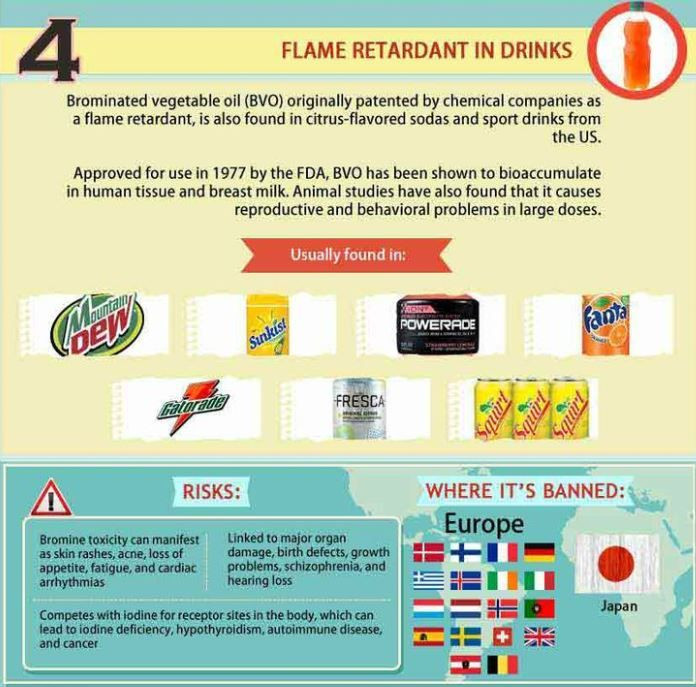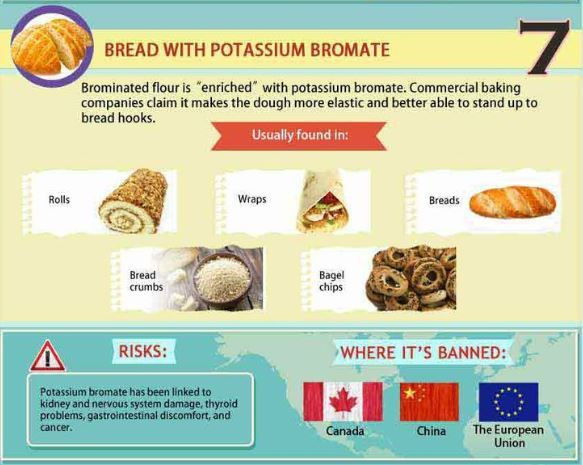Foods To Avoid? 10 Things In Americans' Favorite Foods That Are Banned In Other Countries

In a country so consumed with counting calories, the gluten-free fad, and fast food, the ingredients section on the back of packages are widely overlooked and riddled with internationally banned foods. The health center Mercola has compiled a list of the worst offenders, and they include harmful additives, growth hormones, and genetically engineered ingredients laced throughout foods designed to satiate the unsuspecting American appetite. Maybe the reasons behind why these foods are banned in other countries will fill our bellies with enough disgust and fear, we won’t be hungry for harmful ingredients any longer.
Americans Still Eat These 10 Foods & Ingredients Banned Around The World:
1. Farm-Raised Salmon
Banned in Australia, New Zealand, and Russia.
Salmon has been a hot debate topic in the past decade, especially at a time when overfishing and other environmental concerns are pushing to the forefront. Farmed fish feedlots hold up to one million fish in an area the size of two football fields and are becoming more popular as the world’s fish stocks decline and the American appetite continues to grow. Studies have found contaminants found in farmed salmon are well below the tolerance levels approved by the Food and Drug Administration, but they exceed the safety levels for frequent consumption by the Environmental Protection Agency.
Farmed salmon don’t have a lot of room to swim, don’t follow their natural migration patterns, and have an unnatural diet of grains, which is why they’re fattier than wild salmon and contain 50 percent less omega-3 fats and protein. They’re grown with a mix of antibiotics, vitamins, drugs, and chemicals and don’t have wild salmon’s natural color, so they’re fed a synthetic astaxanthin to achieve the pinkish-red shade. Nearly 90 percent of the toxins farmed salmon contains can accumulate in your body, and if you’re pregnant it can pass on to your newborn baby and secrete through breast milk.
2. Ractopamine-Tainted Meat
Banned in Russia, Mainland China, Taiwan, and 160 countries across Europe
Ractopamine, also known as Paylean and Optaflexx, is a drug fed to livestock to reduce the fat content and enhance muscle, making the meat more profitable per animal. It was originally used to treat asthma and is found in 45 percent of pigs, 30 percent of ration-fed cattle, and an unknown percentage of turkeys. As much as 20 percent of Ractopamine may remain in the meat you purchase with a drug label warning “Not for use in humans” and “individuals with cardiovascular disease should exercise special caution to avoid exposure.”
Ractopamine is linked with decreases in reproductive function and increased death and disability. In humans, it’s known to affect the cardiovascular system, causing hyperactivity, chromosomal abnormalities, and behavioral changes. It’s the meat additive you didn’t expect to land on your plate. But how are you supposed to stop ordering and buying it if you don’t pay attention to what exactly you’re eating?
3. Genetically-Engineered Papaya
Banned in the European Union.
In the 1990s, the ringspot virus greatly threatened the Hawaiian papaya crop. They were genetically engineered to resist the virus, but by 2004 Hawaii reported a widespread contamination of papaya crops by the new variant. Five years later, nearly 20,000 papaya seeks from the islands were contaminated with genetically modified organisms, more commonly known as GMOs, and cows fed the variety suffered a wide range of illnesses. After three generations of cows, they were still experiencing intestinal damage, multiple-organ damage, massive tumors, birth defects, premature death, and near or complete sterility from the GMOs.
Yet, genetically modified papayas remain as the only commercially grown GMO fruit in the U.S. because they were grandfathered in by Hawaii’s County councilmen because it was deeply ingrained in their tradition and made them financially profitable.
4. Flame Retardant in Drinks
Banned in Japan and 18 European countries.
In 1977, the FDA itself approved brominated vegetable oil (BVO), a patented flame retardant used in sodas and sports drinks in the U.S. Recently Coca-Cola and PepsiCo announced they’re working on removing the controversial BVO from their drinks as a result of petitions. The FDA permitted the use of BVO on an “interim basis” pending additional studies to prove its safety or health dangers, but decades later they never conducted those studies.
Bromine toxicity can cause skin rashes, acne, loss of appetite, fatigue, and cardiac arrhythmias. It’s been linked to major organ damage, birth defects, growth problems, schizophrenia, and a slew of other health consequences. Despite animal studies proving it was harmful back in the 70s, it still made its way into Mountain Dew, Sunkist, Powerade, Gatorade, Squirt, Fresca, and Fanta.
5. Processed Foods with Artificial Food Colors and Dyes
Banned Norway and Austria. If it’s not banned in a country outside of the U.S., it requires a warning label.
Red 40, yellow 5, yellow 6, and blue 2 weave their way into the American ingredients list of a wide variety of foods. They’re the most commonly used dyes in the U.S., found in mac-and-cheese, cheddar flavored crackers, Jell-O, and children’s cereals. With more than 3,000 food additives, preservatives, flavorings, colors, and other synthetic ingredients in our foods, research says we’re at risk for cancers, birth defects, allergies, behavioral changes, and increased hyperactivity in kids.
6. Arsenic-Laced Chicken
Banned in the European Union.
Chronic arsenic exposure can cause anemia, headaches, skin lesions, low blood pressure, kidney damage and failure, increased risk of diabetes, miscarriage, stillbirth, low birth weight, and infant mortality. What is arsenic doing in our chicken? Since the 1940s, farmers have been feeding livestock arsenic to fight off disease; however, they now use it to make animals grow quicker and make the meat appear pinker and fresher. It’s not a carcinogen itself, but when it’s consumed by our body it converts into a cancer-causing form. In 2007, nine billion domesticated chickens were still being fed Roxarsone, an arsenic-based feed drug. That’s 70 percent of the chickens grown, slaughtered, and lined up in grocery aisles.
7. Bread with Potassium Bromate
Banned in the European Union, Canada, and China.
Potassium bromate helps make the dough more elastic and to hold up better on the bread hooks that move it through commercial baking factories. It has been linked to kidney and nervous system damage, in addition to thyroid problems, gastrointestinal discomfort, and even cancer.

8. Olestra/Olean
Banned in the United Kingdom and Canada.
Procter & Gamble created this cholesterol-free fat substitute for their fat-free snacks. It was the snacking industry’s answer to their high-fat problem and swiftly approved by the FDA in 1996. People began reporting diarrhea, cramps, leaky bowels, and anal leakage after eating what they thought to be a healthier alternative to indulging. But in 2011, Purdue University researchers published a study that found rats who were fed foods with Orlean gained more weight than those fed a high-fat diet with regular fat potato chips. (You can also find the fake fat in French fries.) Doctors soon discovered their body’s had a difficult time absorbing fat-soluble vitamins such as vitamin A, D, E, and K.
9. Preservatives BHA and BHT
Banned in Japan and the European Union.
At high doses, it causes cancer in animals and can cause organ system toxicity, allergic reactions, and hyperactivity. It’s found in anything from meat, to butter, beer, and breakfast cereals.
The potent antioxidant butylated hydroxyanisole (BHA) and its cousin butylated hydroxytoluene (BHT), prevent fatty or oily foods from going bad because they attack the oxygen molecules to slow down oxidation. When food is exposed to the air, it weakens and degrades into toxic and foul-smelling foods. At high temperatures, vitamin E is an effective alternative to BHA and BHT and can keep foods stable and preserved in the grocery store.
10. Milk and Dairy Products Laced with rBGH




























